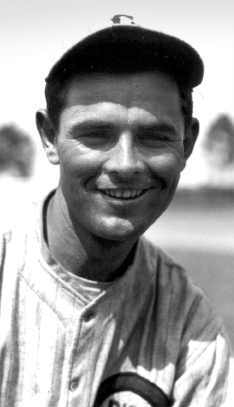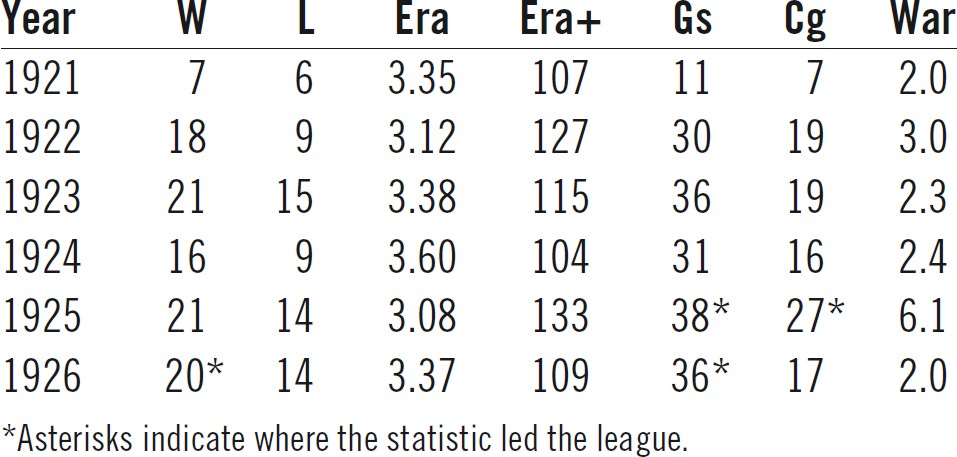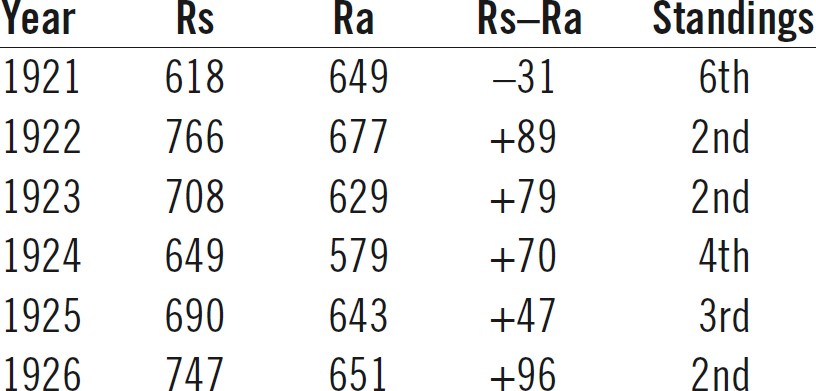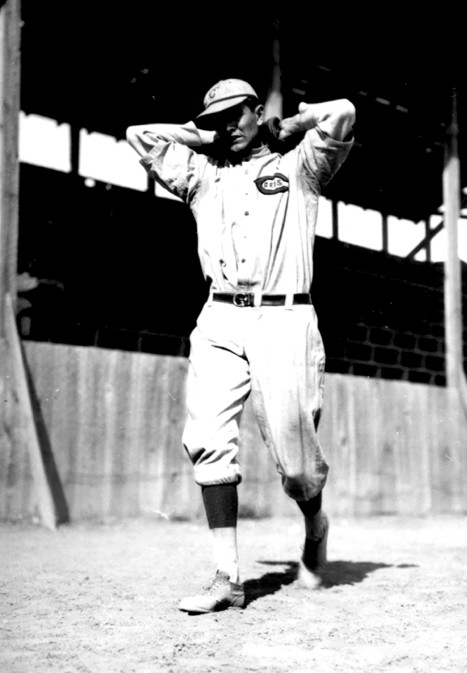From Athens, Texas, to the Cincinnati Reds: The Saga of Pete Donohue
This article was written by Steve Krevisky
This article was published in The National Pastime: Baseball in Texas and Beyond (2025)
A top Texas high school, semipro, and college pitcher, Pete Donohue excelled with the Cincinnati Reds for several years before his effectiveness fell off, possibly due to overuse. (SABR-Rucker Archive)
Pete Donohue pitched 100 years ago and his career is worth exploring, as he was one of the mainstays of the Cincinnati Reds pitching staff in the 1920s. His accomplishments are notable, even in a short career. He was born in Athens, Texas, in the eastern part of the state. He became a North Side High School pitching star in Fort Worth, where he pitched in 31 games, and won 24 of them.1 He also excelled at the semipro level. Pete led the Athens Hornets, a semipro level baseball team, to district titles, going 25-5, with a 1.75 ERA and 175 Ks, winning All-District and All-State honors.2 He then pitched for Texas Christian University (TCU), going 29-4 and hurling four no-hitters, before he signed with Cincinnati. His TCU coach, Kid Nance, taught Pete the change-up, which he used with great success.3
According to the Fort Worth Star-Telegram, Pete’s record over five years in school and semipro pitching was 107-17.4 The Reds gave Pete a $5,000 signing bonus as an amateur free agent in 1920. Pete told the Dallas Morning News that he was swayed to sign with them because they seemed to care about him: “[T]hey took a real interest in me. The other club representatives seemed to be only interested in my alleged pitching powers. It seemed to me that they only wanted me as a chattel to win games for them. They only wanted me as a bolt or a rod or a can to go into the old machinery. But the Cincinnati folks showed an interest in Pete Donohue.”5 By 1921, at the ripe age of 20 years old, he was hurling for Cincy. From then until 1926, he was a key member of the Reds rotation, which also featured Dolf Luque and Eppa Rixey, whom “the Cincinnati Reds Hall of Fame dubbed the ‘most successful and durable staff in Reds history…the Big Three.’”6
The following table shows his pitching stats from 1921 through 1926.
Table 1. Pete Donohue Pitching Stats from 1921 through 19267
Table 1 demonstrates Donohue’s significant accomplishments over this six-year time period. He was a 20-game winner three times in four years, with 1925 being his best season, featuring his best ERA, best ERA + , best WAR, and he led the league in games started and complete games. He was good in 1926, too, as he led in wins, games started, and shut-outs (5). In 1925 and 1926 he bore the heaviest workload of any pitcher, leading the league both seasons with 301 and 285 2/3 innings respectively. The 1925 season is worth special emphasis, not only because 2025 is 100 years since his best season, but also because various sources listed Pete as one of the top moundsmen in the NL that year. For example, the 1926 Sporting News Record Book lists Donohue as the fourth best NL pitcher for 1925, with only three hurlers having better ERAs than him.8 The Hidden Game of Baseball rates him as the second best NL hurler, behind only Dolf Luque.9 And the 2006 ESPN Baseball Encyclopedia ranks Pete second only to Luque in pitcher wins.10
Donohue enjoyed some fine performances in 1925. Highlights include:
- April 18 at Redland Field: A 4-hitter against the Pirates where Pete went 2-for-4, with a double, triple and 3 RBIs, in a 12-2 win.
- April 25 at Sportsman’s Park: A 3 hitter against the Cardinals, resulting in a tight 3-1 triumph.
- July 3 at Forbes Field: An 8-0, 4-hit whitewash of the Pirates, with Pete going 2-for-3.
- September 13 at Cubs Park A 5-hitter against the Cubs, a 5-2 victory.
Pete was a fairly good hitter, especially for a pitcher, as exemplified on May 22, 1925, when he went 5-for-5, with a homer and three RBIs. He batted .294 for that season, and even garnered a vote or two for NL MVP (with 4 total points, good for 15th on the list, one slot below Dolph Luque, who had 5 points). Interestingly, of the 21 players receiving at least one vote for MVP that year, Donohue had the second highest WAR (7.0), topped only by the MVP winner, Rogers Hornsby, who led the league with 10.2 WAR.
The 1925 Reds scored 690 runs, the fewest in the NL, but also only gave up 643 runs, also the fewest in the NL. Both Pete and the Reds were better at home than on the road. Table 2 shows how good the Big Three were.
Table 2. Pitching Stats for the Reds Big 3 in 192511

Table 3 shows how the team performed during Donohue’s six strong seasons. Hall of Famer Edd Roush was the main offensive threat in 1925. He batted .339, with 28 doubles, 16 triples, 8 homers and 83 RBIs. Curt Walker was solid, batting .318, with 22 doubles, 16 triples and 71 RBIs. Rube Bressler weighed in with a.348 BA and 61 RBIs.
Table 3. Cincinnati Reds 1921–192512
This team’s strength is underscored by their achievements in the standings from 1922 to 1926. They finished 2nd in 1922, 2nd in 1923, 4th in 1924, 3rd in 1925, and a close 2nd in 1926, two games behind the Cardinals. Cincinnati had a big improvement over 1921, as the Reds jumped from 70 wins and 6th place to 86 wins and 2nd place in 1922. Some of that was due to a stronger offense, but Donohue’s emergence as a strong pitcher also played a part. After this season, Pete and some other Reds went on a Midwest barnstorming trip, where he pitched in a 6-1 victory, and many of Edd Roush’s fans were present.13
In 1922, Donohue finished 2nd in pitching runs, behind Pirates ace Wilbur Cooper, meaning Cooper prevented the most runs compared to an average pitcher. Although the Reds played in a park that favored pitching, even by normalized ERA, adjusted for league conditions and park factor, Donohue finished third.14
The 1925 season saw Luque, Rixey, and Donohue finish 1-2-3 in pitching runs, park adjusted pitching runs, and normalized ERA. Rixey and Donohue were tied for 2nd in percent of team wins, and Pete was ranked 2nd in the NL in pitchers overall.15 Also, Luque, Donohue, and Rixey were in the top four in Opponents OBP, ERA and adjusted ERA. The Big Three were also 1-2-3 in Pitcher Wins, according to the 2006 ESPN Baseball Encyclopedia.
In 1926, the Cincy boys finished a mere two games behind the pennant winning Cardinals.16 Donohue pitched well down the stretch, hurling three shutouts in September, even though they fell short.17
Pete Donohue was dubbed one of “The Big Three” in the Reds rotation, along with Eppa Rixey and Dolf Luque. (SABR-Rucker Archive)
After Donohue’s 588 2/3 innings pitched 1925-26, whether due to injury or illness, his performance dropped substantially and he was never the same again. Pete’s nephew, Jim Pemberton, reported “[Pete] told me he’d been spiked and nearly died of blood poisoning. They’d actually given him up, but he came back. But after that, he favored the injured leg and ruined his pitching motion.’”18 Donohue also claimed that he was overworked, but a 1927 article in the Cincinnati Enquirer reported he had also been hit by a batted ball in the ankle during batting practice, causing him to miss three weeks of the season.19 After a few subpar years, he was traded to the Giants. He then went to Cleveland, and ended up in Boston. He also made minor league appearances, finally retiring in 1933.
He remains one of the few Reds pitchers to have three or more 20-win seasons. Noodles Hahn had four such seasons, and Paul Derringer did as well. Pete Donohue deserves to be better remembered for his accomplishments.
STEVE KREVISKY has been a professor of mathematics at Connecticut State Community College, Middlesex Campus, for many years. His students get used to him bringing baseball into classes to make it more interesting for them. He is also President of the Smoky Joe Wood SABR chapter, which has periodic meetings, chapter breakfasts, and trips to local minor league games. He has been attending SABR’s annual conventions for many years, going back to his first convention in Chicago in 1986. He has been a frequent presenter, has published articles in the journals, and has also been on seven teams that won the trivia championships over the years! He looks forward to returning to Texas for this year’s convention. He is in a simulation/fantasy league, and looks forward to that committee meeting as well as seeing old friends there!
Additional Sources
Carter, Craig. Daguerreotypes 8th Edition. New York: Sporting News, 1990.
“Pete Donohue.” Retrosheet. Accessed April 22, 2025. https://www.retrosheet.org/boxesetc/D/Pdonop102.htm
Sugar, Bert Randolph and Ken Samelson. The Baseball Maniac’s Almanac. New York: Sports Publishing, 2023.
Notes
1. Bill Nowlin, “Pete Donohue,” SABR BioProject, https://sabr.org/bioproj/person/pete-donohue/, accessed April 22, 2025.
2. Nowlin, “Pete Donohue.”
3. Nowlin, “Pete Donohue.”
4. Fort Worth Star-Telegram, June 12, 1921: 11.
5. Nowlin, “Pete Donohue.”
6. Nowlin, “Pete Donohue.”
7. “Pete Donohue,” Baseball Reference, https://www.baseball-reference.com/players/d/donohpe01.shtml, accessed April 22, 2025.
8. Paul Rickart, The Sporting News Record Book for 1926 (St. Louis: CC Spink, 1926), 8.
9. John Thorn and Pete Palmer, The Hidden Game of Baseball (New York: Doubleday, 1985), 344.
10. Gary Gillete and Pete Palmer, The 2006 ESPN Baseball Encyclopedia (New York: Sterling Publishing, 2006), 1544.
11. “Giants Return Home: All Will Be Seen in Games with Yale at Polo Grounds To-day,” The New York Times, April 9, 1913: 10.
12. Thorn and Palmer, The Hidden Game of Baseball, 340-345.
13. Thomas Barthel, Baseball Barnstorming and Exhibition Games, 1901-1962 (Jefferson: McFarland Publishing, 2007).
14. John Thorn and Pete Palmer, The Hidden Game of Baseball, 341.
15. Thorn and Palmer, The Hidden Game of Baseball, 342.
16. Thorn and Palmer, The Hidden Game of Baseball, 345.
17. Nowlin, “Pete Donohue.”
18. Nowlin, “Pete Donohue.”
19. Jack Ryder, “Winning Streak Narrowly Escapes Ruin ad Reds Win, 11-10,” Cincinnati Enquirer, July 27, 1927, 9; Nowlin, “Pete Donohue.”
